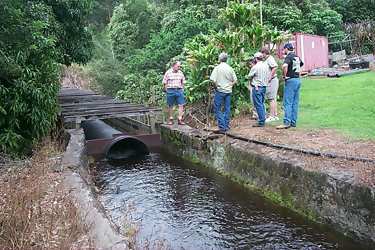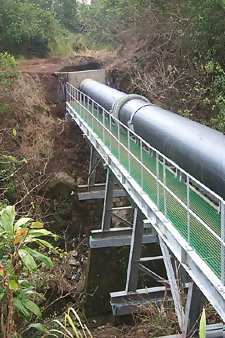
National Watershed Coalition members were fortunate to be able to tour one of the most unique NRCS watershed projects in the nation recently while attending the NACD national convention on the Big Island of Hawaii.
The Lower Hamakua Ditch Watershed, located on the island of Hawaii, State of Hawaii, will provide many of the watershed area communities with a key component to economic recovery following the collapse of the sugar industry during the mid-1990s. The Lower Hamakua Ditch Watershed is a region of approximately 38,500 acres which is hydrologically integrated by the Lower Hamakua Ditch agricultural water system.
The Public Law 83-566 Watershed project is intended to provide small startup farmers, many of whom are former sugar industry workers, with necessary irrigation water and conservation assistance. The project will help ensure the continued existence and use of the nearly century-old Lower Hamakua Ditch agricultural water system, protect the agricultural use of farmland, and help preserve the rural character of the Hamakua area.
The centerpiece of the Watershed Plan is repair of the Lower Hamakua Ditch to provide affordable and dependable irrigation water supply to 2,500 acres of diversified agriculture and drinking water for 2,600 head of cattle. The Lower Hamakua Ditch was constructed in the early 1900s and was completed in July 1910. The Lower Hamakua Ditch extends from intakes at the back of Waipio Valley and flows through ten miles of tunnel to "daylight" near the community of Kukuihaele. The "open ditch" portion extends nearly 15 miles across the Hamakua area at an elevation of approximately 900 feet mean sea level to the community of Paauilo. The ditch was originally designed to use Waipio Valley spring and stream sources to flume hand-harvested sugarcane stalks from upland fields to the processing mills located along the Hamakua coastline. In later years, as mechanized sugar harvesting and processing evolved and as irrigation systems developed, the Lower Hamakua Ditch was used primarily for wash water at the sugar mills and as a source of irrigation water. The Lower Hamakua Ditch initially had a delivery capacity of about 40 million gallons per day and currently operates in a 25 to 30 MGD range.
The project shows the diversity and flexibility of the Small Watershed Program to deal with many different types of agriculture and natural resource issues.


Above: Opening of 10 mile tunnel that empties into century-old sediment pool. Right: NRCS staff discuss map of Hamakua Ditch project with NWC Chairman Dan Lowrance.


Hamakua Ditch PL-566 Project - Big Island of Hawaii
